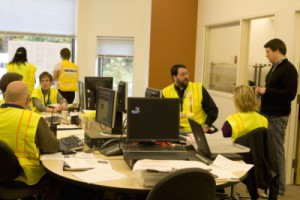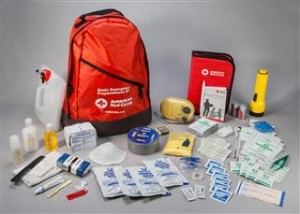What is Emergency Management?

Employees conducting an emergency drill in the PLU Emergency Coordination Center
Emergency Management protects communities by coordinating and integrating all activities necessary to build, sustain, and improve the capability to mitigate against, prepare for, respond to, and recover from threatened or actual natural disasters, acts of terrorism, or other man-made disasters.
There are four phases of Emergency Management: Mitigation, Preparedness, Response, and Recovery. Please take a look at the tabs below for each phase to learn more about emergency management at Pacific Lutheran University.
What is Mitigation?
Mitigation is preventing future emergencies or minimizing their effects. It includes any activities that prevent an emergency, reduce the chance of an emergency happening, or reduce the damaging effects of unavoidable emergencies. Buying flood and fire insurance for your home is a mitigation activity. Mitigation focuses on long-term and sustained solutions to reducing risk. Mitigation activities take place before and after emergencies.
- Please Visit our Documents page to view PLU’s Hazard Mitigation Plan
PLU & Region 5 Hazard Mitigation Plan
PLU, in conjunction with 69 cities, towns, special purpose districts (fire, utility, school, port, etc.) and private non-profits in Pierce County, participated in the update of its existing Hazard Mitigation Plan. Once the Updated Plan was adopted by the PLU Board and approved by Washington State Emergency Management and Federal Emergency Management Agency, PLU became eligible for Pre and Post Disaster Hazard Mitigation Funds from the Federal Government.
Pierce County Department of Emergency Management is responsible for the coordination and development of the Plan. The Plan update was completed by the fall of 2014.
The Plan is comprised of the following sections: a Profile Section, a Risk Assessment Section, a Capability Identification Section, a Mitigation Strategy Section,and a Plan Maintenance Section as well as appropriate Appendices.
For further information, open Region 5 Mitigation Plan at: www.co.pierce.wa.us/mitigation or contact Richard Schroedel at (253) 798-6596 or rschroe@co.pierce.wa.us Mitigation Planner at the Pierce County Department of Emergency Management.
Hazard Mitigation Projects
PLU submitted two PDM grant applications for funding to improve the seismic integrity of two PLU residence halls – Stuen and Ordal. The total project costs for Stuen and Ordal was approximately $2.1 million. A benefit cost analysis, using the Federal Emergency Management Agency (FEMA) modeling tool, results in more public benefit than cost making the projects eligible for funding. Funding was granted to PLU in 2012. With this funding, PLU has retrofitted these buildings to a Life-Safety structural engineering standard, meaning it has improved the buildings’ abilities to withstand earthquake shaking and damage that would otherwise result in injuries or deaths. These projects began in 2013. Stuen’s update was completed in fall of 2014 and Ordal’s update was completed in the summer of 2015.
Retrofitting these buildings will likely result in less demand for emergency services in the case of a regional disaster and will enable PLU to continue to house its own community safely, as well as supporting the surrounding community.
PLU installed card access locks in Olson and Rieke in 2010 and Hauge in 2012 with the help of a Homeland Security Non-profit Security Grant. The locks enable faster lock down during a violent incident.
PLU completed seismic retrofits of Hinderlie and Hong residence halls during the summer of 2009 with the help of the FEMA Hazard Mitigation Grant Program. Stuen has also received seismic retrofits during the 2013-2014 academic year and was completed in the fall of 2014.
In addition, PLU has performed seismic retrofits of several other buildings on campus, installed card access locks in residence halls and a number of administrative buildings, and installed earthquake sensitive natural gas shut-off valves throughout campus.
What is Preparedness?
Preparedness is preparing to handle an emergency, a state of readiness to respond to a disaster, crisis, or any other type of emergency incident. It includes plans or preparations made to save lives and to help with response and rescue operations. Evacuation plans and stocking food and water are both examples of preparedness. Preparedness activities take place before an emergency occurs.
Get a Kit.
Make a Plan.
Be Informed.
There are three simple steps that students should take to prepare for an emergency when living on campus or in off-campus housing:
1. Purchase or prepare a personal emergency kit.
2. Develop a communication plan for reaching family members in the event that normal communication channels are disabled.
3. Know what to expect and what to do at PLU during various types of emergencies.
Following are a few guidelines to consider in taking these three steps. Please also refer to the PLU Prepare in a Year brochure in the Quick Links to the right.
Get an Emergency Kit
 Emergency kits can be easily assembled yourself from items at home. This is the most cost effective option, but also requires a little more effort. Some inspiration for a basic emergency kit can be found at https://www.ready.gov/kit
Emergency kits can be easily assembled yourself from items at home. This is the most cost effective option, but also requires a little more effort. Some inspiration for a basic emergency kit can be found at https://www.ready.gov/kit
If you are a commuter student or a staff/faculty member who relies on a car to get to and from campus, consider keeping preparedness items in your vehicle. Some ideas on vehicle safety items can be found at https://www.ready.gov/car. Please note that if you store items in your vehicle, you should keep them in the trunk or in another out of view area to discourage theft.
Emergency kits can also be bought through many retailers, and you can compare prices and items you need to get the best fit!
Make a Communication Plan
Local telephones, cell phones, and e-mail may not work during an emergency. However, it is often possible to call outside the local affected area. Your family should make a plan to call an out-of-state friend or family phone number, so each person can report they are safe. Here is a template your family can use to keep track of this information.
Look For Web, Phone, and Media Alerts
PLU Alert! may be used to notify students and employees of unfolding emergency incidents via text and voice message to cell phones, PLU work phones, and PLU email addresses that are on record with the university. For more information, click here.
Parents and students may also find updated crisis or emergency information on the PLU Web site, www.plu.edu, and by calling the incident hotline, 1-877-322-0872.
Weather closure information is available three ways: 1) online at www.plu.edu and at www.flashalert.net, 2) by calling 1-877-322-0872, and 3) by following local broadcast information.
For more information about notification services please click here.
Take an Active Role in Your safety
Be Prepared for all Hazards ready_full-suite_hazard-info-sheets
What is Response?
Response- Includes actions taken to save lives and prevent further property damage in an emergency situation by responding safely to an emergency. The response is putting your preparedness plans into action. Seeking shelter from a tornado or turning off gas valves in an earthquake are both response activities. Response activities take place during an emergency.
Campus Safety is PLU’s primary response organization, though many other offices and individuals carry out and support response functions depending on the size and scope of the incident.
In 2008, PLU adopted the National Incident Management System (NIMS) as its methodology for responding to emergencies. Having done so enables PLU to coordinate effectively with local responders, such as the Sheriff’s Department and Central Pierce Fire and Rescue.
Take a look at PLU’s All Hazards Emergency Management Plan to see how PLU plans to respond to an emergency.
What is Recovery?
 Recovery involves decisions and actions relative to rebuilding homes, replacing property, resuming employment, restoring businesses, and permanently repairing and rebuilding infrastructure. It includes actions taken to return to a normal or even safer situation following an emergency. Recovery includes getting financial assistance to help pay for the repairs. Recovery activities take place after an emergency.
Recovery involves decisions and actions relative to rebuilding homes, replacing property, resuming employment, restoring businesses, and permanently repairing and rebuilding infrastructure. It includes actions taken to return to a normal or even safer situation following an emergency. Recovery includes getting financial assistance to help pay for the repairs. Recovery activities take place after an emergency.


